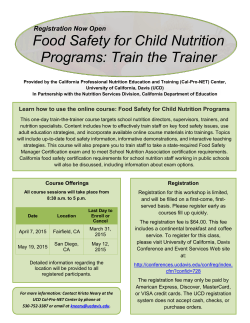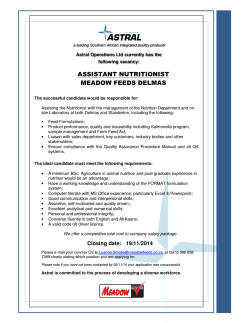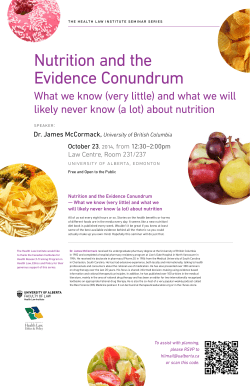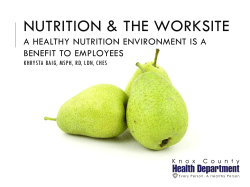
COURSE TITLE: PUBLIC HEALTH
COURSE TITLE: STUDY HOURS: 120 PAPER: 3 TERM: 2nd PUBLIC HEALTH MARKS THEORY: PRACTICAL/VIVA: TIME: The following Public Health contents will be taught briefly. 80 20 2:30 Hrs Course contents: A. Basic Definition 6 A1 public heath A2 health A3 Disease A4 Illness A5 Iceberg of Disease A6 Social Medicine A7 Social Hygiene A8 Medical Care A9 Preventive Medicine A10 Level of Prevention B. Primary health care B1 Primary health Care (PHC) B2 Concepts of Primary Health Care B3 Components of Primary Health Care B4 Equity B5 Effectiveness B6 Efficiency B7 ALMA ATA Declaration B8 Health for All by the Year 2000 C. Human Nutrition C1Nutrition C2 Nutrients and its classification C3 Diet C4 Balanced Diet and its principal of preparing C5 Calorie C6 Malnutrition C7 Starvation C8 Nutritional Status C9 Nutrition Assessment 6 18 C10 Recommended Daily Allowances C11 Functions of Nutrients C12 Food Groups C13 Preservation of food C13.1Cooling C13.1 Drying C13.3 Salting C13.4 Smoking C13.5Canning C13.6 Chemical Preservation D Nutritional Needs in Physiological states D1 Infancy and childhood D2 Adolescent Nutrition C3 Adult’s nutrition C4 Nutrition during pregnancy & lactation C5 Geriatric Nutrition E Nutrition Disorders E1 Vitamin A deficiency disorders E2 Vitamin B1 and B12 deficiency disorders E3 Iron deficiency disorder E4 Vitamin C deficiency disorder E5 Vitamin D G Malnutrition G1 Factor Affecting malnutrition G2 Protein energy malnutrition G3 Obesity D. Community Water supply 6 D1 Introduction D2 Importance of water D3 Uses of water D4 Classification of water D5 Sources of water D6 Purification of water D7 Examination of water D8 Water Related disease D8.1 Non-infection water related disease like Metheamoglobineamia in Infants and Gastric & Bladder Cancers D8.2 Infection water related disease like Dysenteries, Hepatitis A and Typhoid etc E. Sanitation E1 Definitions E2 Importance of sanitation E3 Refuses E4 Collection, Removal and disposal of refuse E5 Method for final elimination of refuse E6 Collection removal and disposal of human excreta E6.1 Dry or conservancy system E6.2 wet system or sewerage system E7 Hospital waste management E8 Environment pollution E9 Causes of environment pollution 6 F. Mother and child health (MCH) 12 F1 Definition F2 Objective of MCH F3 Concept of safe mother hood F4 Maternal health F5 Antenatal care F1 Antenatal Visit F2 Antenatal Service for Mothers F3 Antenatal advice F6 High-Risk Pregnancies F7 Breast Feeding and its advantage and disadvantage F8 Breast care during lactation F9 Preparation of Brest during pregnancy F10 Brest Care F11 Disadvantage of artificial feeding F12 Weaning F13 High risk children F14 Care of the new born G Management of premature and IUGR baby G1 Physical examination of new born G2 Growth monitoring in child health H. Family planning H1 Definition H2 Concept of family planning H3 Effects of population growth H4 Factor affecting population growth H5 Counseling for contraception H5.1 Contraception H5.2 Contraceptive methods H5.3 Side Effects of contraceptive I. Immunization I 1 Introduction I 2 Immunity I 3 Vaccines I 4 Expanded programme of immunization (EPI) I 5 Cold chain & its maintenance I 6 Vaccination schedule I 7 Methods of delivering vaccines I 8 Adverse effects of vaccines I 9 Community involvement in immunization J. Infectious diseases: 10 9 Introduction, Clinical features and Prevention (Briefly) of the following diseases 10 J1 Measles J2 Rubella J3 Whooping cough J4 Diphtheria J5 Rabies J6 Tetanus J7 Chicken pox J8 Mumps J9 Typhoid fever J10 Bacillary dysentery J11 Food poisoning J12 Tuberculosis J13 Poliomyelitis J14 Pertussis J15 Bird flue J16 Dengue K. Tropical disease: Introduction, Clinical features & Prevention (Briefly) of the following diseases K1 Malaria K2 Amoebiasis K3 Cholera 2 Introduction, Clinical features & Prevention (Briefly) of the following diseases L1 Aids L2 Gonorrhea L3 Syphilis 2 Introduction, Clinical features & Prevention (Briefly) of the following diseases 2 L. Sexually Transmitted Diseases: M. Diseases of liver M1 Viral hepatitis M2 Cirrhosis M3 Liver failure M4 Hepatitis A, B, C and E N. Mental health 6 O. Drug abuse 4 P. Health education 4 N1 Mental health definition N2 Mental illness N3 Popular beliefs N4 Classifications of health mental N5 Mental health problem N6 Concepts of community mental health N7 Prevention of mental illnesses N8 Community of mental health center O1 Introduction O2 Phases of addication O3 Types of drugs abuse O4 Causes of drugs abuse O5 Effects of drugs abuse O7 Preventive measures P1 Definition P2 Health promotion P3 Important of health education P4 Responsibility for health education P5 Stages of health education P6 Principal of health education P7 Planning for health education program P8 Methods and techniques of health education Q. Health management information system 3 R. EPIDEMIOLOGY 3 Q1 Definition Q2 Essentials of management information system Q3 A well-designed MIS should have the following factors Q4 Important of MIS R1 Definition R2 Determinants R3 Clinical epidemiology R4 Occupational epidemiology R5 Important of Epidemiology R6Health indicators R6.1 Crude birth rate R6.2 Crude death rate R7.3 Infant mortality rate R8.4 Life expectancy at birth R9.5 Growth rate R10.6 Fertility rate S. HEATH SYSTEM RESEARCH 6 T. BIOMEDICAL ETHICS 6 S1 Definition S2 Importance 3 Epidemiological methods S4 Disease screening S5 Sensitivity S6 Specificity S7 Control of disease epidemic T1 Introduction T2 Equity T3 Utility T4 Equality T5 Human Rights T6 Autonomy T7 Beneficence T8 Non-malfeasance T9 Justice Recommended Books: Public health for PARA Medic and nursesby Dr. Khalid Mahood. Reference BookK Park’s community medicine (Reference Book) by K Park 2003 published by BanarsideBhanot Jaipur India
© Copyright 2025











